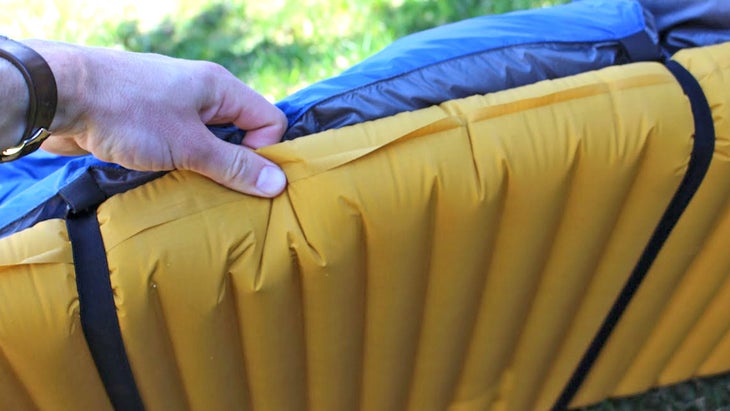Quilt or Sleeping Bag? Here's How Backpacker's Gear Editor Decides

(Photo: Benjamin Tepler)
For the uninitiated, there’s a lot of fear around using a quilt while backpacking. Most casual backpackers see quilts as an ultralight compromise—one that will leave you shivering. As an absolute wuss when it comes to being cold, I’m here to tell you that using a quilt is for everyone, most of the time. That said, there are times when only a bag will do. Here’s how I choose.
A quilt is just what it sounds like: a down blanket that covers your front like a comforter and lacks a hood. The science behind quilt design says that laying on compressed down in a normal sleeping bag doesn’t do us very much good. We need our insulation to stay lofty and full of air to do its job. (Also critical: a sleeping pad with an appropriate R-value for your climate.) With the bottom half of the bag out of the equation, you save a ton of pack weight. Something like the Katabatic 22 Flex quilt weighs nearly 11 ounces less than an ultralight bag with a similar down fill and temperature rating, like the Big Agnes Fly Creek UL 25. But I’m not into quilts just because they’re ultralight.

Why I Bring a Quilt
Simply put, beyond the weight-savings, quilts provide a ton of flexibility. They’re comfortable on hot nights and well below freezing with an appropriate temperature rating and sleeping pad. For finicky sleepers like myself, you can turn on your side, starfish on your belly, and flip on to your back without getting tangled like you would in a sleeping bag. You can unzip most quilts into what is essentially a down sheet, making them perfect for warm summer nights where even a 40-degree bag would be overkill. And on cold nights, you can batten down the hatches with included cord or webbing that attaches to the underside of your pad, preventing drafts. Most quilts also have draft collars around the neck and footbox and cinch tight to prevent heat-loss. Some brands have optional hood attachments, although I find that wearing a beanie, putting on a puffy jacket with a hood—both things you’ll already be carrying—or snugging my nose down into the quilt does a great job down into the 20s. (Be sure to size up if you want to cover your head.)
Why I Bring a Sleeping Bag
What about a traditional mummy? I’ll grab one anytime I’m winter camping—and often when I’m cowboy camping, too. While cinches and straps do a great job of sealing the quilt 98-percent of the time, even a tiny gap will keep you awake when it’s 10 degrees out: It’s true that sleeping bags don’t provide a ton of insulation below you when compressed, but they do a great job of air-sealing and keeping drafts out. And when you’re cowboy camping out in the elements, morning dew, unexpected drizzle, or a blustery night isn’t much fun without a hood. But the main reason I see experienced campers using mummies in the fairweather season? The psychological factor. There’s something incredibly soothing about being swaddled in a down pod. And for some folks, that’s reason enough.


